Dingo diets are important to understand — another way that dingoes are different to dogs is the food that they eat. Australian dingoes have very specific diets, for good reason: there are certain types of food that dingoes just can’t eat.
But first, an important note about why you should never feed a wild dingo.
Never feed a wild dingo
This article is about the dingo diet in my house, with our adopted dingoes, Rusty and Jalba. Rusty and Jalba were both orphaned as cubs and have been in our home for over a year now. Our dingoes obviously rely on us to feed them, whereas this reliance on humans is not desirable in the wild.
Never feed a wild dingo.
Feeding wild dingoes can lead to dependence, they might lose their ability or desire to hunt, they can become desensitised to humans and you might be feeding them food that they shouldn’t be eating.
Feeding wild dingoes encourages them to be in places where humans are, which isn’t ideal, for example, mine sites, camping grounds, beaches etc. For your own safety, do not feed wild dingoes. Feeding wild dingoes is unsafe and can result in aggression towards you or other people now and in the future.
K’gari (Fraser Island) has a population of wild, protected dingoes and it’s actually an offence to feed the dingoes at K’gari. If you feed a wild dingo at K’gari, you can be fined anything from $400 to over $5000. If you’re visiting K’gari, it’s vital that you review the guidelines about dingoes, to ensure you keep you and your family safe, and also to ensure you do your part to protect dingoes.
In addition to K’gari, wild dingoes can be found in other parts of Australia. On a trip up to Exmouth, my family and I saw wild dingoes on the beach at Turquoise Bay. The first was a lone dingo walking along the shore at dusk, and the other was during the day when the beach was quite busy. Remember that dingoes move quickly; if you’re in dingo territory, always keep young children within arms reach and brush up on the local dingo advice.
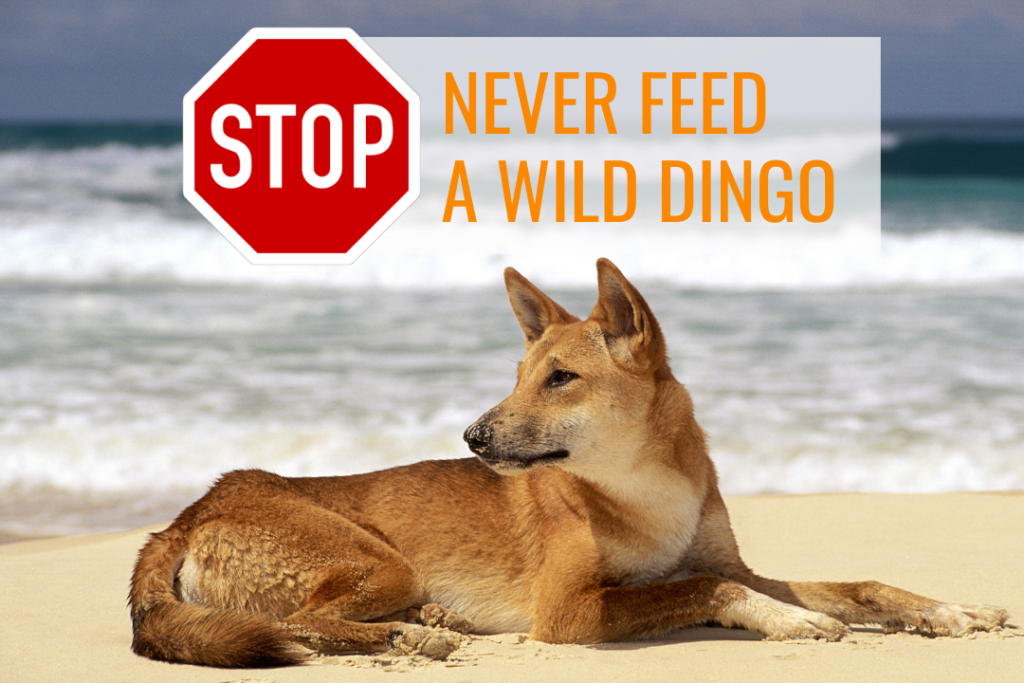
Dingo diet: what our dingoes eat
Our dingoes are technically living in captivity — they were once wild dingoes but due to unfortunate circumstances they no longer live in the wild. You can find out more about our dingoes here.
Daily dingo diet
The short story is that dingoes eat a raw diet of high protein, in other words: lean meat.
It’s been a learning process for us and we’ve had some great information given to us about dingo diets from dingo groups and Rusty’s last carer.
Dingoes can’t process carbohydrates and they don’t process fat very well, so they eat very lean meat such as kangaroo and chicken and they eat it raw.
So you’ll see in my video below that we source kangaroo meat from a local supplier. On an average day, each of our dingoes will eat 250g of kangaroo chunks and a couple of chicken drumsticks, as well as some special kibble. About every second day they also get an egg, usually in their bowl but sometimes on its own, outside. Jalba’s not too great at cracking eggs so we usually help him out with that.
Kangaroo meat from the supermarket is food grade for humans, so it’s quite expensive. Our roo meat is not food grade for humans, so always keep that in mind when dealing with food purchased for animal consumption. We could probably buy our chicken cheaper elsewhere, but we don’t have a chest freezer, so we buy our chicken fresh from our local supermarket every few days.
Grain free kibble
Dingoes can’t process carbohydrates, and if you take a look, you’ll notice that almost every bag of kibble in your local pet store has carbohydrates: potato, sweet potato, wheat, tapioca etc. Don’t even get me started on the fillers in a lot of kibble brands: there’s a lot of junk out there.
If you’re looking for kibble that is good for a dingo diet, look for kibble that is mostly protein, with zero or very little carbohydrates. The WA Dingo Association recommended this brand to us and it’s been great.
Holistic Select Grain Free
Holistic Select is a USA based pet food supplier and all their dried food products are manufactured in Indiana, USA. This kibble is great for dingoes for a few reasons:
- No carbohydrates (no wheat, no potato etc)
- High protein (salmon, anchovies and sardines)
- Added digestive enzymes
The added enzymes are great, because these help our dingoes process any carbohydrates they do happen to consume, for example, Rusty has taken a bite out of one of my kids’ croissants and there is a little bit of pumpkin in this kibble. Dingoes can be opportunistic, so it’s likely they’ll consume carbohydrates on the odd occasion, although we don’t usually leave food within their reach.
Since we started with this kibble (about 9 months ago) our dingoes have been healthy, their coats have been full and healthy and they absolutely love it.
The only catch with this kibble is that per kilogram, it is a lot more expensive than other brands. Kibble isn’t an essential part of a dingo diet, so the amount we give them varies each day and we only give a maximum of one cup per dingo, per day. You can purchase Holistic Select kibble at PETstock and they also deliver (quick tip: ask them to price match with another store!).
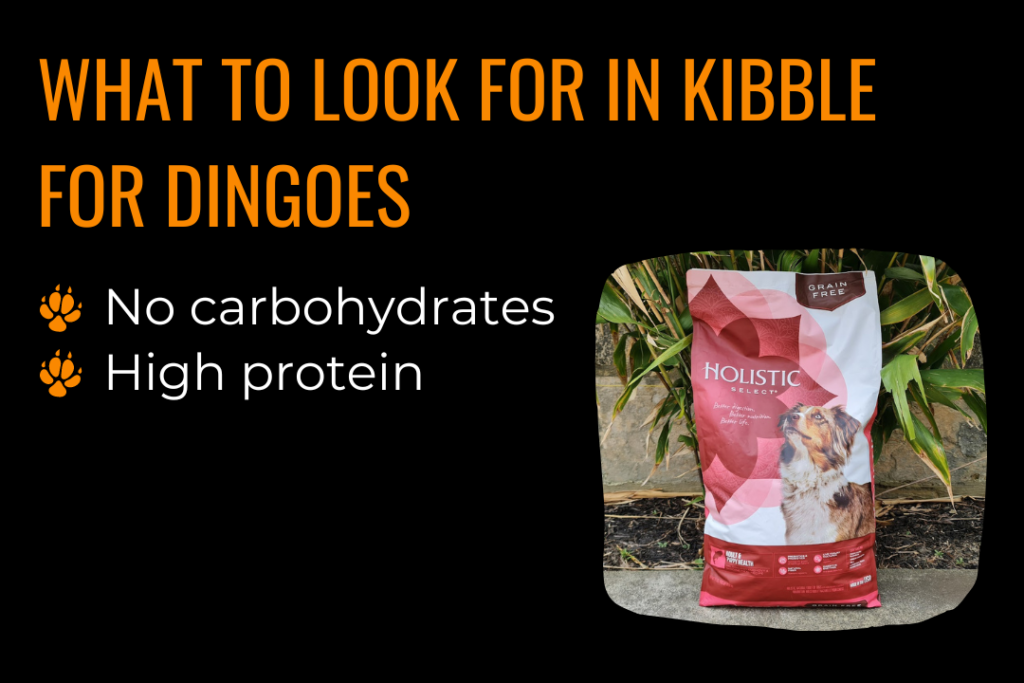
Dingo diet: “sometimes” foods
There’s no doubt that our dingoes’ meals could be better, and we’ll keep working on it over time. There are other types of food that we give our dingoes occasionally.
When we have the time to keep our dingoes separate, we’ll give them a dried kangaroo forearm, or fresh kangaroo tail. It’s important for dingoes to eat fur so we try and get these when practical. You can find out why in my video.
We gave Rusty a kangaroo rib cage once but it took over a day to eat, which isn’t great because we keep our dingoes separate when they’re eating meat and doing that all day just isn’t practical.
They also have the occasional chicken frame or dried kangaroo meat like ears, ribs, tendons and feet.
Others feed their dingoes some amazing foods, check out Canine Ascension for some inspiration and the Dingo Den.
Dingo diet: training treats
When it comes to training, our dingoes absolutely love shredded roast chicken, but they’re a bit overenthusiastic with this so we don’t use this regularly.
The hardest part about finding training treats is finding grain free treats, so we spend a lot of time checking labels. We used to use a wet food that they loved, the type that comes in rolls and is refrigerated, but Rusty was a bit sick recently, possibly from this food, so we’ve stopped buying it for a while. If we use it again and our dingoes are okay, I’ll let you know what it’s called.
Sometimes we use kibble for training, but sometimes this isn’t high-value enough to keep their attention. They like Ziwi Peak Air Dried Chicken, which is literally just chicken, so it’s perfect. There are no added ingredients, they love the taste and they’re easy to use for training since it comes in small pieces that are flat, about 1cm square.
It’s a bit expensive but most grain free treats tend to be on the pricey side. You can find it at Pet City in Australia.
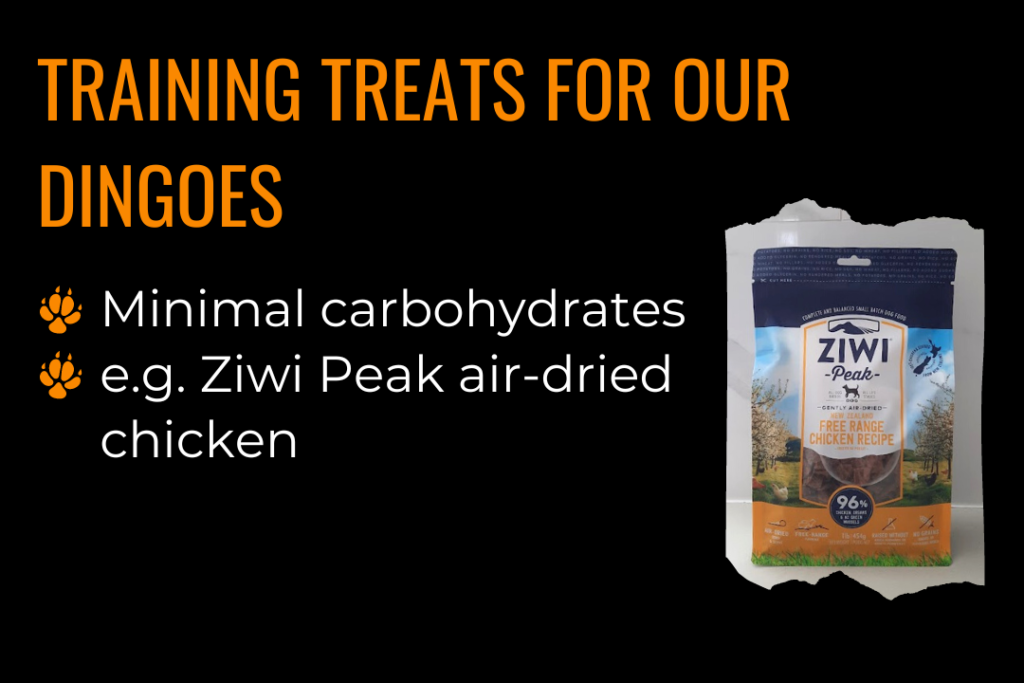
How we feed our dingoes
Daily dingo meals
We rarely put kibble in their bowls and we allocate a maximum of one cup per dingo per day. Usually we give them their kibble while we train them at home (like doing the “nothing” game or training them to “wait”) or sprinkle it around the yard. We usually sprinkle it around outside if they seem like they’re hungry in the morning, if we’re heading out of the house or if we want them to calm down a bit (sniffing is great for dingoes and dogs).
They eat their main meal anytime from about 2-6pm. We put their meat in separate bowls, and feed Rusty inside and Jalba outside. Rusty always gets his bowl first, otherwise it leads to a bit of disharmony between them. We keep them separate until Jalba finishes, he’s the slower eater.
Their meat is raw so we’re always super careful to clean up afterwards and keep their containers separate from ours.
When Jalba was a bit younger he used to have breakfast. By the time he came to us he was five months old, so for about a month, we gave Jalba kibble and an egg for breakfast, in a bowl, and also gave some to Rusty so he didn’t feel left out (but we gave him much less).
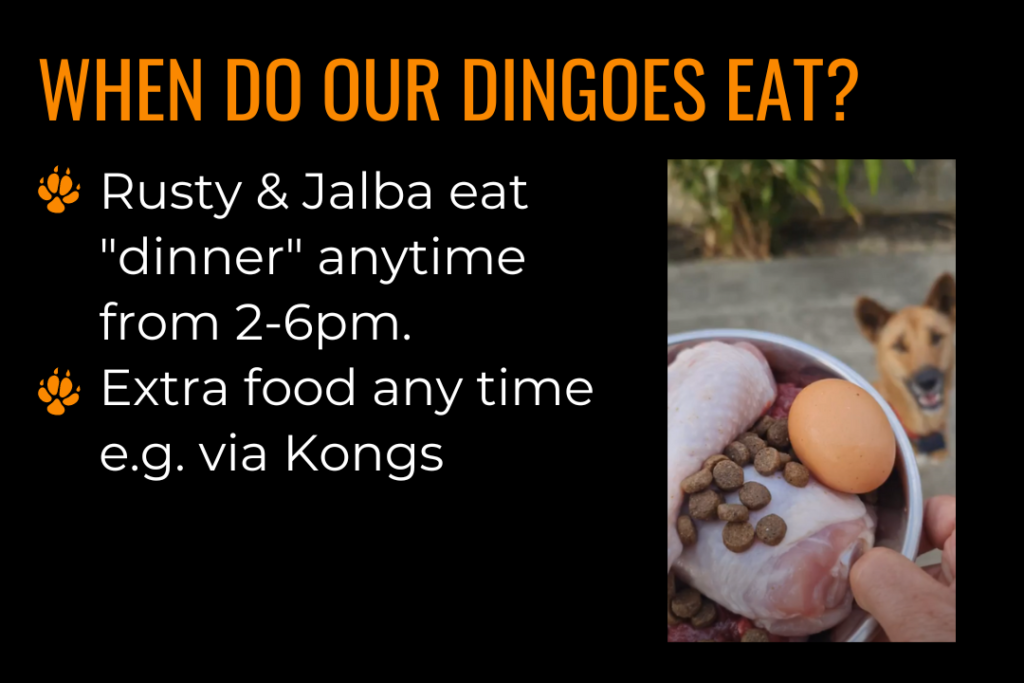
How do we know if our dingoes are full?
We know because they’re happy! They often have a nap after they eat.
We do our best not to give them too much food — if we do, they’ll hide it and eat it later, which isn’t very safe given we have two dingoes; it can lead to dingo disagreements. We can also tell if we’ve been overfeeding by looking at their ribs. A dingo’s ribs are supposed to be visible — they are very lean animals. Once Rusty’s ribs are no longer visible, it means we’ve been overfeeding. Jalba’s have always been harder to see, so we usually make the judgement based on Rusty.
Dingoes are great communicators and we can always tell if they’re still hungry — this usually comes in the form of Rusty approaching us near the kitchen, sitting without being asked, looking directly into our eyes and chortling his hungry chortle and sometimes pawing at the kitchen gate. He doesn’t break eye contact if he’s hungry, just holds his gaze steady. This doesn’t happen very often, and if it does, an egg usually does the trick.
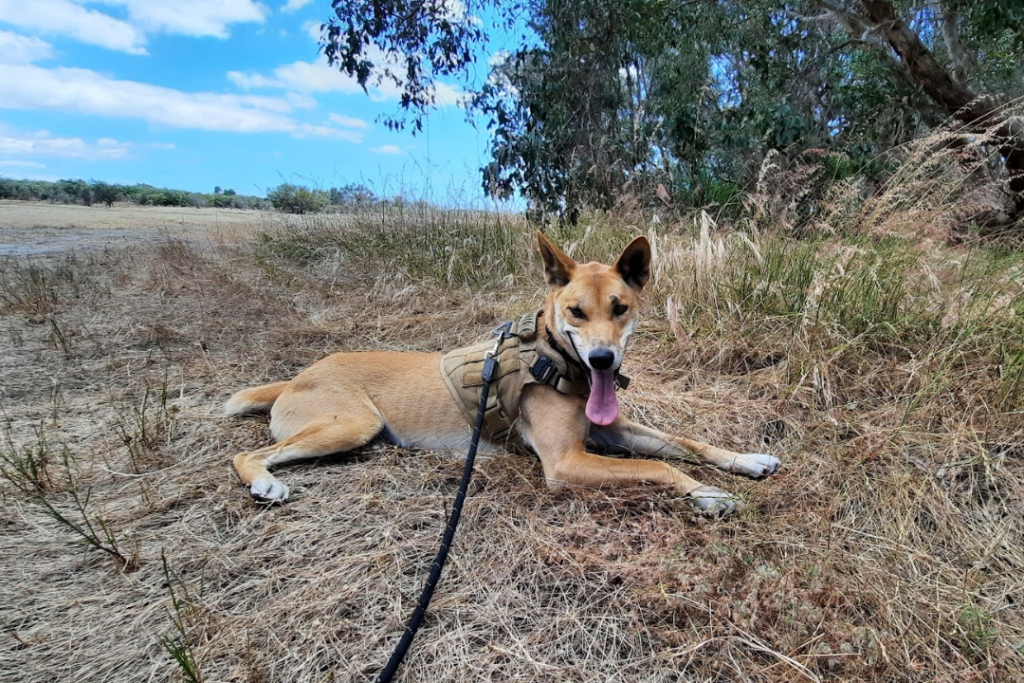
Keeping dingoes busy with food
Dingoes, like dogs, love to chew. Chewing, sniffing and licking all help to keep a dingo calm, happy and eventually, a little bit tired. Some people follow “ditch the bowl” philosophy, which basically means not feeding with a bowl and using your dog or dingo’s food for training. We still use the bowl but we do other things to help our dingoes chew, sniff and lick and this also helps us manage having them at home.
Check out Shay Kelly’s Canine Enrichment Facebook group, which has almost half a million members, but if you have a dingo, keep their specific needs in mind.
We have likimats which we freeze, as well as Kongs. Sometimes we also freeze food and liquid in 2 litre ice cream containers and tip these out for the dingoes outside — these are great because they last longer and Rusty can’t steal Jalba’s since it’s a big block of ice.
Likimats are only given under supervision, because they could destroy those in seconds, so we take the mats as soon as they are done. We give our dingoes the frozen Kongs or big ice blocks if we want to keep them happy outside, such as during dinner, early in the morning, or if we’re leaving the house.
So what do we put in the Kongs and ice cream buckets? A combination of layers: tuna, sardines, mackerel, kibble, leftover cooked chicken (no bones), egg and small amounts of Greek yogurt, cheddar cheese, cottage cheese and we’ll often add a dried treat so it’s sticking out of the end. We never put raw meat in these, because leaving our dingoes unsupervised with raw meat is likely to lead to an ugly tussle.
We use the Kong Extreme from PetBarn. It’s super important to note that when you fill this type of Kong, you need to put a straw through it so that your dingo’s tongue doesn’t get stuck inside. We remove the straw before giving it to them, by running a bit of hot water through the straw using a funnel.
All about dingo diets
So I hope this article about dingo diets has helped. I know it’s had a focus on dingo diets in captivity and there are definitely more types of food they could be eating. I’d love to hear from more people who have adopted Australian dingoes and from dingo adoption shelters and dingo organisations. Let us know what your dingoes eat in the comments below.
And remember: never feed a wild dingo.
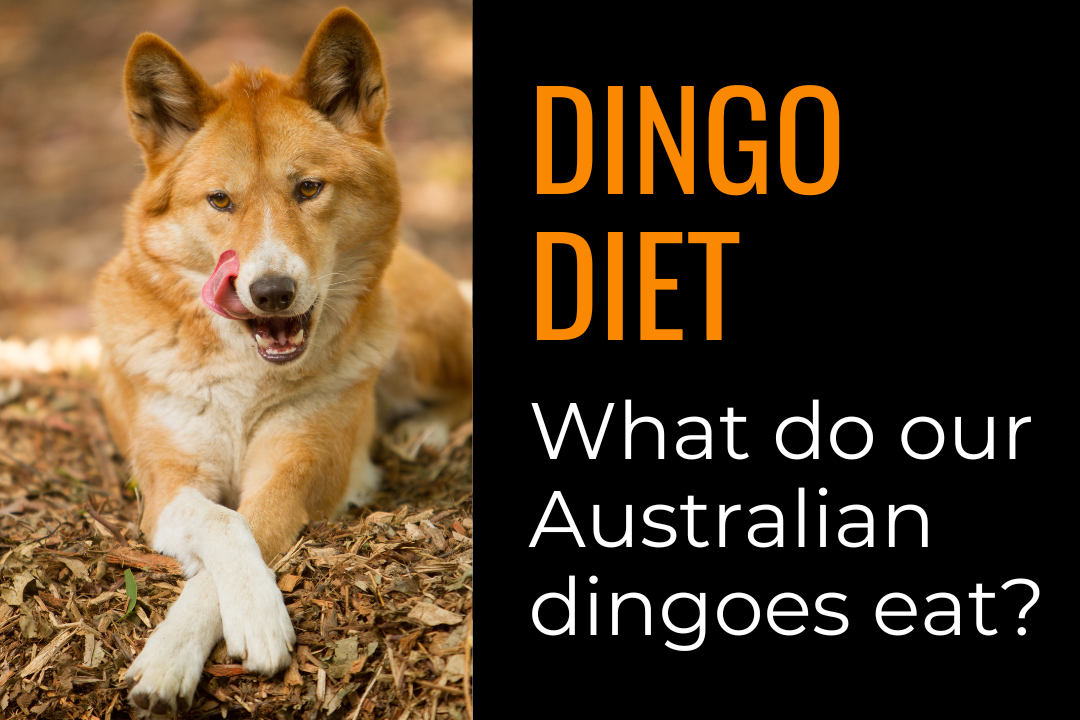
0 Comments